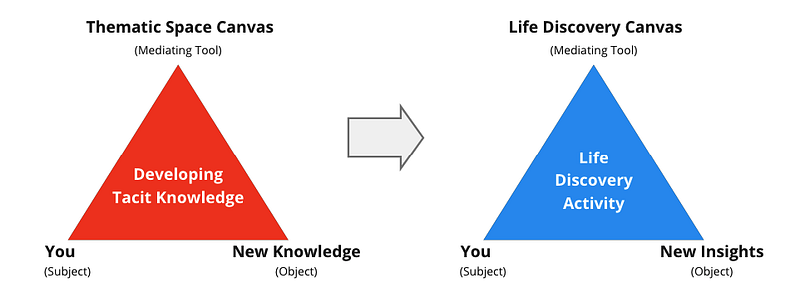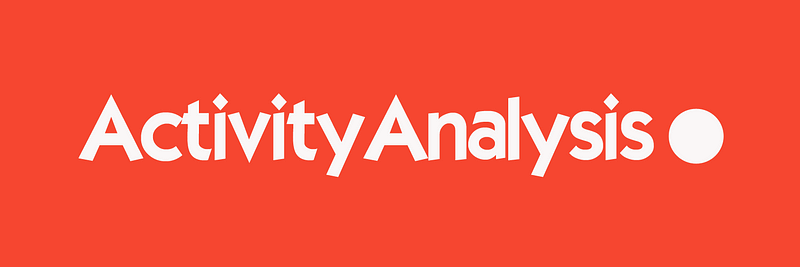Activity Analysis Center: Curativity, Creativity, and Activity

Finally, I start running the Activity Analysis project as an independent knowledge center.
For each knowledge center, I use three keywords to describe its focus. For the Activity Analysis Center, the focus is described with the following themes:
- Curativity
- Creativity
- Activity
Curativity
The term “Curativity” means the project is a Knowledge Curation project. If you know the historical development of the project, you know it was born from the Activity U project which is all about curating theoretical approaches to Activity Theory.
Activity Theory or the “Cultural-historical activity theory (CHAT)” is an interdisciplinary philosophical framework for studying both individual and social aspects of human behavior.

On August 10, 2020, I wrote an article titled The Landscape of Activity Theory. Yesterday I republished it on the Activity Analysis website. If you want to know the outcome of the Activity U project, you can check the last section of the article.
It was the starting point of the Activity U project (2020 to 2022). You can check out a board on Milanote to explore the three-year journey.

I will keep going in the direction of Knowledge Curation. But, I will expand the scope from Activity Theory to other social practice theories. It means the Activity Analysis project is not only about Activity Theory, but also about other social practice theories.
Since 2001, a group of philosophers, sociologists, and scientists have rediscovered the practice perspective and used it as a lens to explore and examine the role of practices in human activity. Researchers called it The Practice Turn in Contemporary Theory. As Schatzki pointed out, “there is no unified practice approach”(2001, p.2). Davide Nicolini introduces the following six different ways of theorizing practice in his 2013 book Practice Theory, Work, & Organization:
- Praxeology and the Work of Giddens and Bourdieu
- Communities of Practice (Lave & Wenger, 1991)
- Activity Theory / Cultural-historical activity theory (the Marxian/Vygotskian/Leont’evian tradition)
- Ethnomethodology (Harold Garfinkel, 1954)
- The Site of Social (contemporary developments of the Heideggerian/Wittgensteinian traditions, by Theodore R. Schatzki)
- Conversation Analysis / Critical Discourse Analysis (the Foucauldian tradition)
Nicolini also pointed out, “Practice theories are fundamentally ontological projects in the sense that they attempt to provide a new vocabulary to describe the world and to populate the world with specific ‘units of analysis’; that is, practice. How these units are defined, however, is internal to each of the theories, and choosing one of them would thus amount to reducing the richness provided by the different approaches.” (2012, p.9)

The above diagram represents the mission of the Activity Analysis project: Modeling Social Practices. We aim to connect THEORY and PRACTICE by curating theoretical knowledge, designing service programs, and building a learning community.
Activity Analysis Center will work together with Curativity Center which is a knowledge center for developing Curativity Theory.
Creativity
The term “Creativity” refers to my own knowledge creations such as the “Project Engagement” approach, the “Anticipatory Activity System” framework, the “Life-as-Project” approach, the “Creative Work Study” project, the “Activity Circle” model, etc.
It also refers to my creative design activities of making instruments for some particular activities. For example:
- Knowledge Discovery Canvas (Instrument) for Developing Tacit Knowledge (Activity)
- Life Discovery Canvas (Instrument) for Life Discovery Activity and Developing Life Strategy (Activity)
The “design thinking” behind Knowledge Discovery Canvas and Life Discovery Canvas is pretty unique. See the diagram below.

I started from the basic model of Activity Theory: Subject — Mediating Tool — Object. You can find more details in the Concept of Mediation.
I consider both “Developing Tacit Knowledge” and “Life Discovery” as Activities. From the perspective of Activity Theory, these two canvases are both Mediating Tools or Instruments.
Moreover, what I found is that “Life Discovery” can be understood as a subcategory of “Developing Tacit Knowledge” if we consider the target of knowing as a person’s own life development. The process of discovering new insights for life development is a process of Developing Tacit Knowledge.
We also use the “Themes of Practice” framework to watch the development of a particular possible practice. For example, the diagram below shows the micro landscape of the practice around the theme Developing Tacit Knowledge with the Thematic Space Canvas.

Activity Analysis Center will work with CALL (Creative Action Learning Lab) on Creative Design and Ecological Practice Design.
Activity
For the Activity Analysis project (2022–2024), the term “Activity” refers to a large thematic space: human activity and social practices.
There are two types of practice domains: horizontal domains and vertical domains.
- Horizontal domains refer to general functions in society such as “organization, strategy, and innovation”.
- Vertical domains refer to specific industries, for example, farms (agriculture), buses (transportation), and movies (entertainment).
We will start with horizontal domains and expand to vertical domains. Inspired by the naming approach of Academy of Management’s Divisions and Interest Groups (DIGs), we set six Learning Interest Groups (LIGs) to represent horizontal domains about knowledge works.

- Organization, Strategy, and Innovation (OSI)
- Product, Design, and Service (PDS)
- Knowledge, Work, and Creativity (KWC)
- Information, Genre, and Communication (IGC)
- Platform, Digital, and Transformation (PDT)
- Learning, Education, and Development (LED)
Activity Analysis Center will work with Platform Ecology Center on Platform-based Social Practices.
This is your community. You are welcome to find or create your learning interest group.
I will pay attention to connecting THEORY and PRACTICE by developing various tools and programs.
Though we offer ideas and tools for understanding human activity and social practices, we encourage you to adopt these ideas and tools to improve your work, your life, and your communities.
The best way of adopting theoretical concepts and knowledge frameworks for real lifeworld is to conduct empirical research. There are many ways of doing empirical research. If you are not familiar with methods of academic research, you can start with simple case studies one by one.
You can also see your own life experience as data for empirical research. In this manner, you can adopt the self-reflection approach to conduct case studies.
The most essential thing behind empirical research is finding new insights in order to improve our understanding of the world and design new actions to change the status quo.
Stay curious, and be patient, this is a long journey for your epistemic development.

- Official website: https://www.activityanalysis.net
- Twitter: https://twitter.com/activitycall
- Linkedin Group: https://www.linkedin.com/groups/14111718/
